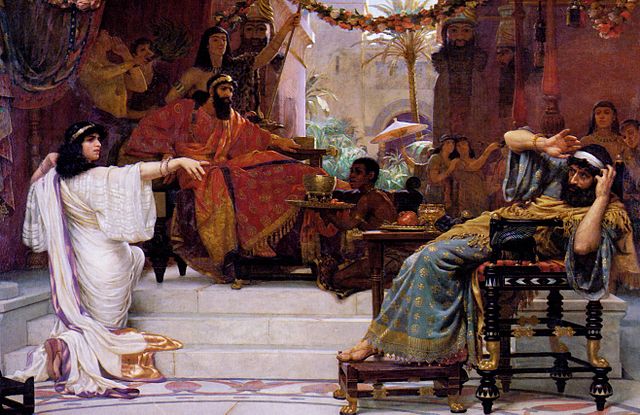www.aljazeerah.info
Opinion Editorials, April 2019
Archives
Mission & Name
Conflict Terminology
Editorials
Gaza Holocaust
Gulf War
Isdood
Islam
News
News Photos
Opinion Editorials
US Foreign Policy (Dr. El-Najjar's Articles)
www.aljazeerah.info
The Story of Esther and Netanyahu's Attack on Iranian History By Sina Toossi NIAC, April 28, 2019 |
 |
 |
|
| Painting of Biblical Esther denouncing Haman by Ernest Normand |
US Secretary of State Mike Pompeo recently declared that he believes it is “possible” that President Trump was sent by God to protect the Jewish people from Iranians. Pompeo’s remarks came during an interview with the Christian Broadcasting Network, after he was asked if “President Trump right now has been sort of raised for such a time as this, just like Queen Esther, to help save the Jewish people from an Iranian menace.” In likening Trump to Esther, Pompeo added that he was “confident that the Lord is at work here.”
Aside from the preposterous notion that President Trump enjoys divine support, Pompeo’s remarks distort the story of Esther and demonize the Iranian people and their history. Nor is Pompeo’s framing of this Biblical story new. Israeli Prime Minister Benjamin Netanyahu has long twisted the Old Testament’s book of Esther to advance a hawkish agenda on Iran. Such rhetoric from Pompeo and Netanyahu is demagogic hyperbole at best and dangerous incitement against the Iranian people at worst.
Importantly, Pompeo’s comments occur in the context of the Trump administration’s “maximum pressure” campaign against Iran, marked by a unilateral withdrawal from the July 2015 Iran nuclear deal, the imposition of draconian U.S. sanctions that are impoverishing ordinary Iranians, and senior Trump officials exploring options to launch U.S. military strikes.
For his part, Netanyahu has sought to cynically and erroneously frame the story of Esther to reflect an age-old Iranian enmity for the Jewish people. Although Iranian officials have for 40 years engaged in deplorable anti-Israeli vitriol and threats, Netanyahu’s narrative of the story of Esther goes beyond censuring the Islamic Republic. Instead of targeting the current Iranian government, Netanyahu has chosen to go after Iran’s pre-Islamic past.
Netanyahu has long connected the story of Esther to modern times and suggested that Iranians have sought the Jewish peoples’ destruction since the days of the Achaemenid Persian Empire. During the Jewish holiday of Purim in 2017, for instance, he asked a group of school children, “Who wanted to kill us?” After garnering chants of “Persia,” he exclaimed: “Today in Persia they also want to destroy us.”
Netanyahu said on another occasion in 2017: “There is an attempt by Persia’s heir, Iran, to destroy the state of the Jews.” In March 2015 too, during his controversial address to Congress in which he lambasted President Obama’s nuclear negotiations with Iran, he proclaimed: “Today the Jewish people face another attempt by yet another Persian potentate to destroy us.”
Claiming that the story of Esther portrays Persians as wanting to wipe out the Jewish people, or that Iranians have had an eternal and unceasing animosity toward the Jewish people, is wholly unfounded. As Jewish author Yoram Hazony details in his book God and Politics in Esther, the vast Achaemenid Persian Empire was tolerant for its time. As Hazony explains, Esther was a Jewish Queen in the court of the Persian King Ahasuerus, which some religious scholars believe to be Xerxes I of the Achaemenid Empire. Ahasuerus, Hazony notes, had done away with the Persian tradition of consensus-driven decision making and delegated immense authority to a courtier called Haman.
Contrary to assertions made by Netanyahu that Haman was a “Persian viceroy,” he was in fact not Persian but an Amalekite, according to Hazony. A perennial enemy of the Jewish people in the Old Testament, the Amalekites were, like the Jewish people, a nation exiled by the Babylonians. Haman had risen to his position years after the Persian King Cyrus the Great famously conquered Babylonia and liberated the Jewish people and other persecuted groups.
With his powerful status in Ahasuerus’s court, the vociferous anti-Semite Haman hatched a plan to exterminate all Jews within the realm. Ahasuerus, whom Hazony portrays as a “bumbling and insecure” king, initially tolerated the genocidal plot. However, Esther convinced the king to abandon the plan and execute Haman. Ahasuerus then helped orchestrate the destruction of Haman’s allies who were bent on wiping out the Jews. According to the Bible, 75,000 were killed throughout the empire as a result.
The story of Esther is ultimately one of a Persian ruler helping to save the Jewish people, not unlike Cyrus the Great. Notably, despite the restrictions and repression that most Iranians face in modern-day Iran, the country today has the largest community of Jews in the Middle East outside of Israel. It is home to dozens of active synagogues, kosher stores, and a Jewish member of Parliament.
Netanyahu’s framing of the story of Esther is not only a misrepresentation of the traditional tale, but also evokes ugly episodes in history of leaders using religious texts to demonize enemies and advance their political ambitions. Too often, such rhetoric has led to nothing more than needless conflict and loss of innocent life. In today’s context of dangerously high tensions in the Middle East and the Trump administration’s aggressive Iran policy, fear-mongering using the Bible only heightens the potential for a catastrophic war that would have devastating consequences for U.S. interests and all regional people.
Sina Toossi is a Research Associate at the National Iranian American Council (NIAC). He tweets @SinaToossi.
https://lobelog.com/the-story-of-esther-and-netanyahus-attack-on-iranian-history/
***
Share the link of this article with your facebook friends
|
|
|
|
||
|
||||||


